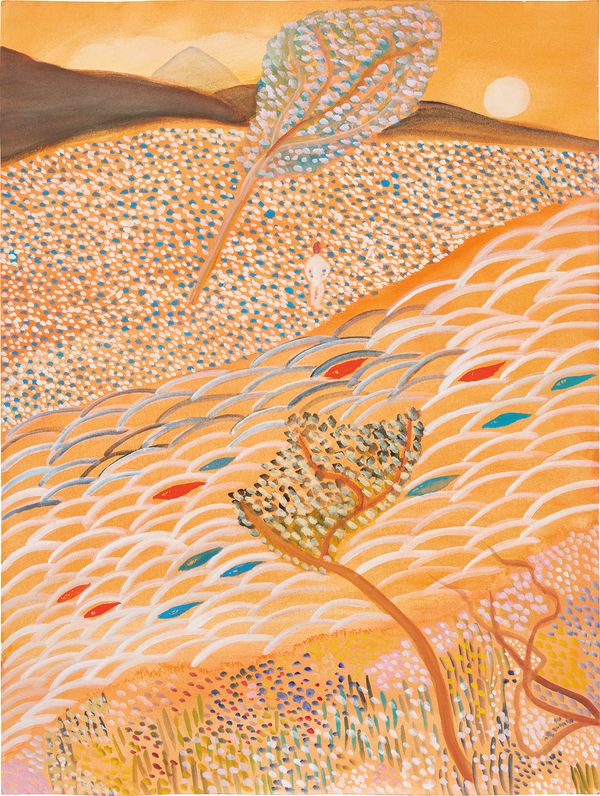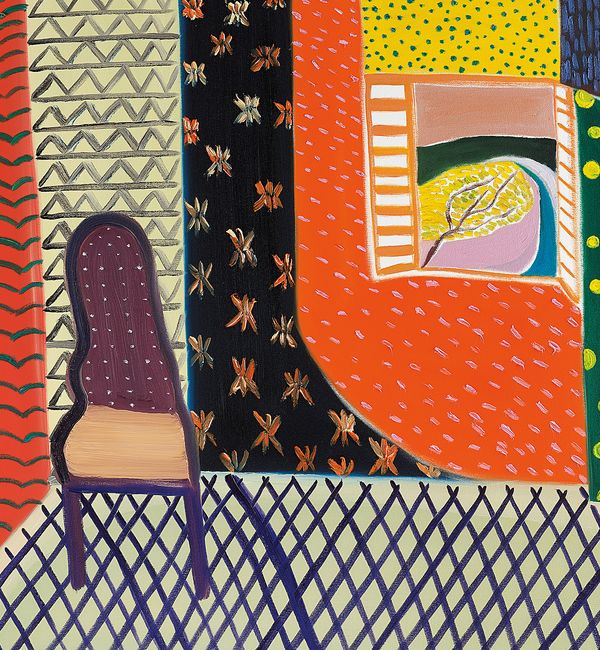Matthew Wong Mood Room, 2018. Estimate: $60,000-80,000.
20th Century & Contemporary Art Evening Sale, New York.
Matthew Wong’s refulgent paintings are prisms of art history. From Chinese literati painting to the expressive brushwork of Vincent van Gogh and Chaim Soutine, the Nabis and Henri Matisse’s fervor for color to the gestural approach of the Abstract Expressionists, numerous influences are palpable in his vibrant vignettes. An enigmatic, psychologically-charged depiction of a space of the artist’s imagination, Mood Room is a superb example from the brief yet profound body of work Wong executed before his untimely death last year.
A self-taught artist, it wasn’t until 2012 that Wong first began to experiment with drawing. “At first I just bought a cheap sketch pad along with a bottle of ink,” Wong said, “and made a mess every day in my bathroom randomly pouring ink onto pages — smashing them together — hoping something interesting was going to come out of it.” The artist’s mother recalled that “he would go to libraries and study all the masters—Picasso, van Gogh, Matisse,” and participated in Facebook communities of artists who introduced him to new techniques and ideas. Among these online friends included painters Peter Shear and Brian Calvin, and prominent art dealer John Cheim even counseled Wong on which oil paint to try.
Matthew Wong Landscape with Young Bather, 2018. Estimate: $20,000-30,000.
20th Century & Contemporary Art Day Sale, Afternoon Session, New York.
Landscape with Young Bather, 2018, also epitomizes Wong’s celebrated landscape paintings informed by modernist traditions. Replete with rich color and pattern, the present work nods to the hypnotic pointillism of Georges Seurat and the moody skyscapes of Vincent van Gogh. Here, the lone, almost indiscernible figure, further enriches the meditative quality of this work on paper as he moves in tandem with the rhythmic waves of his surroundings.
Wong began his paintings with no predetermined subject in mind, instead starting with brushstrokes and dots until an image appeared to him, usually in the form of an interior scene, as in Mood Room, or a landscape, as in Landscape with Young Bather. At this point, Wong stated, “the image will eventually paint itself.” The resulting image usually includes one or no figures, and instead inanimate objects become animate: the chair in Mood Room is depicted with as much presence as a human subject would hold. Perhaps this pictorial decision comes from his background in photography, in which Wong received his MFA before shifting to painting.
Matthew Wong Mood Room, 2018 (detail).
The ambiguous presence Wong’s objects carry, as well as the myriad patterns that adorn his space, also evoke the interiors of modernism. On one hand, Mood Room’s lonely interior alludes to the multitude of designs that furnish both Jonas Wood and Pierre Bonnard’s spaces. There is also a more conceptual connection to history, however; both windows in Mood Room and Matisse’s highly-decorated The Dessert: Harmony in Red, 1908, Hermitage Museum, St. Petersburg, appear simultaneously as frames for paintings. The windows both look out onto brilliant outdoor scenes composed of flat areas of color and dots, evoking both actual trees and pointillist paintings—thus hinting at a “picture within a picture.” In this sense, Wong has placed past and present in dialogue in Mood Room, reimagining the modernist approach for the contemporary era.


